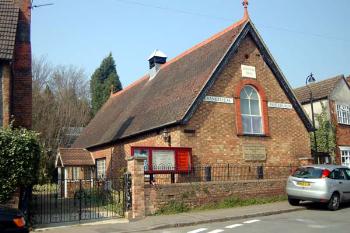Aspley Guise British School

Courtney Memorial Hall, the former British School, March 2007
In the early 19th century Aspley Guise had both Anglican and Methodist Sunday Schools. So, for a while, it had both National and British Schools. British Schools were an attempt to teach children without reference to the catechism of the Church of England and thus tended to be supported mainly, but not exclusively, by nonconformists. The history of the school, such as it is, given the lack of historical documentation, was traced in note form by Arthur Parker [X395/53].
The school was probably established in 1842 (the date on the gable end of the Courtney Memorial Hall) in a former barn in The Square which was especially rebuilt to accommodate it. This had belonged to Richard Thomas How but passed, at his death in 1835 to his nephew William who, in his turn, left it to his widow Lucy in 1862. Thus either William or Lucy How was responsible for establishing the school . The first known teacher was John Wood, who was noted as schoolmaster in a directory of 1850 and was still there a year later when the census was taken.
A report of 1850 on the school noted that 91 children were present, the school was very effective at arithmetic and technical subjects, less so at intellectual ones - one is tempted to see this as a result of most of the children being those of small businessmen and shopkeepers, often a staple of nonconformity in Bedfordshire, for whom technical subjects, particularly arithmetic for book keeping would have been most important. The next year the inspector noted that the general plan of instruction had been "decidedly advanced since the last inspection" with less emphasis on technical teaching though the girls were doing too much fancy needlework rather than plain designs, overall, though the inspector decided it was "A most favourable specimen of a country British school". By 1877 John Palmer was listed as schoolmaster.
In Lucy How's will of 1886 she referes to the British School but it is not mentioned in a directory for the county of 1885 and may have closed soon after the creation of a School Board for the parish in 1878. Lucy died in 1889, having left the building, with How Cottage and Saint Christopher, to her nephew Frederick Corder. He immediately sold it Henry Paul Harris, and the conveyance refers to the building as the Mission Room formerly used as a British School [CRT130Asp19]. Today the building is called The Courtney Memorial Hall.